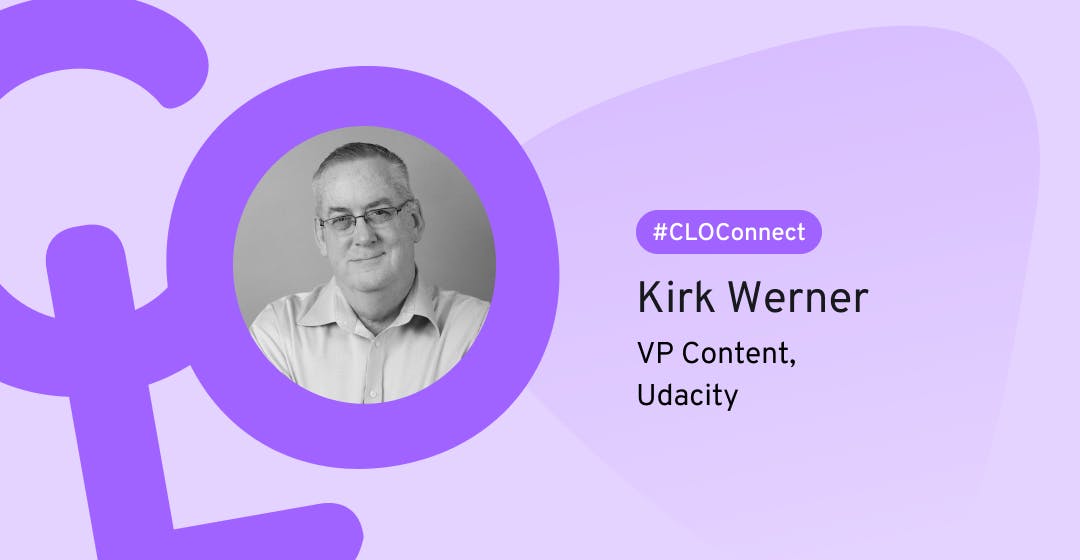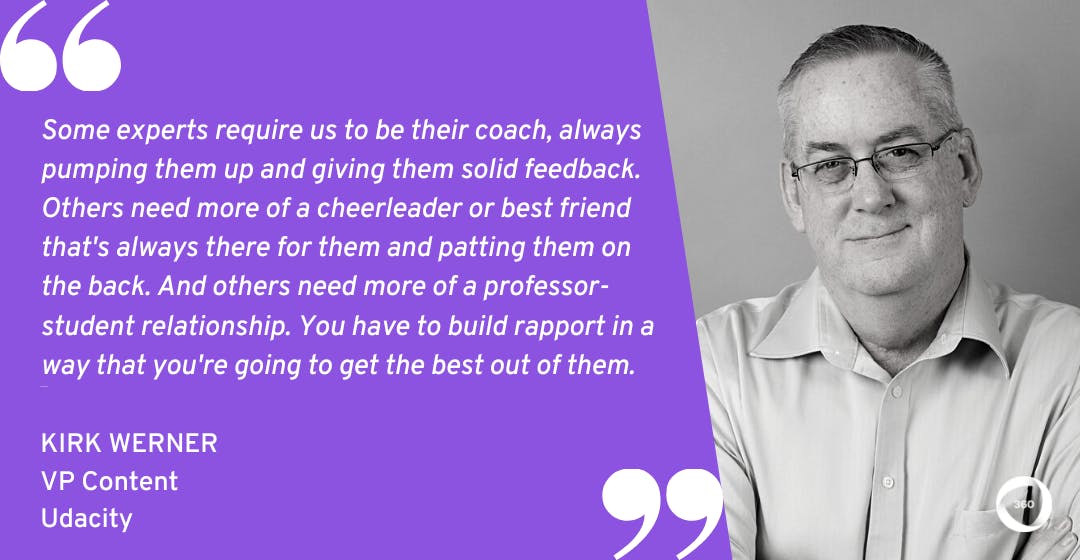
Udacity’s 4 Steps for Creating Memorable Learning Experiences with Subject-Matter Experts
As L&D leaders, we know how critical subject-matter experts are in developing learning content that is meaningful, impactful, and reflects the true depth of your organization’s collective knowledge.
But we also know there can be challenges when partnering with external or internal experts. So, how can you channel this expertise to create memorable learning experiences that will make a real difference for every one of your learners?
Recently, I had the chance to speak with Kirk Werner, Vice President of Content at Udacity, about this very question. I was excited to hear about how he partners with experts to create the best possible content both for clients and for his organization, and how he develops learning experiences that people truly remember.
Read on to hear why developing and growing subject-matter expert partnerships is so crucial for a talent transformation company like Udacity.
Loving what you’re reading? Come and join the L&D Collective for more great learning insights, resources, and events!
The challenge of creating both internal and external content
As the Vice President of Content at Udacity, Kirk supports the content organization that creates the learning they provide for their customers and clients.
“Udacity is a talent transformation platform company,” he explains. “We provide learning experiences and talent transformation opportunities for organizations large and small, from individual consumers all the way up to governments and institutions.”
Kirk also advises on the content that Udacity uses for their own learning. “One of the fascinating parts about the job that I have,” he says, “is that we're often consulting with our internal HR teams and L&D teams to build internal training, either for onboarding other departments or creating broad-scale learning initiatives inside of an organization.”
But what’s Kirk’s strategy for getting the best from both internal and external subject-matter experts (SMEs)? Read on to hear about his four key steps.
Looking for more expert insights? Find out how L&D leaders at Amazon, WhatsApp, Klaviyo and more are driving growth with the right L&D strategy.

You have questions–the experts have the answers
By providing your contact info, you agree to receive communications from 360Learning. You can opt-out at any time. For details, refer to our Privacy Policy.
Udacity’s 4 steps for collaborating with SMEs to create meaningful content
As Kirk explains, engaging with internal and external experts can be quite different experiences.
“Oftentimes,” he says, “when we're building internal content we're working with internal subject-matter experts. So the questions of time management, resource management, and pulling the information out are a lot different when there isn’t an external paycheck that's attached to it, but just an internal job function.”
So how does Kirk collaborate with SMEs to create the best content possible? First, he encourages both SMEs and his team to adopt a ‘learner first’ mindset.
1. Adopt the ‘learner first’ mindset
First, a great collaboration with SMEs starts with understanding what it's like to be a learner.
“Some experts have forgotten what it's like to be a beginner,” Kirk explains. “They're very good at being great at what they do, but it's difficult for them to put that beginner hat on.”
Kirk also finds that the instructional design or learning team has to approach content creation not only from the perspective of the learner, but of the content editor, too.
“You have to be able to say, ‘I think we're going down a road that's going to lead us to a deep, deep, deep cave and we don't want to go that far into that topic, so let's pull it back a little bit’. There's a lot of coaching that goes on on the editorial side.”
2. Tailor your communication style to suit the expert
Next up, Kirk finds and identifies the right communication style for each SME.
“Some of the SMEs require us to be their coach,” Kirk explains, “always pumping them up and giving them solid feedback along the way. Others need more of a cheerleader or best friend that's always there for them and patting them on the back and getting them excited about what's next. And others need more of a professor-student relationship.”
“You have to build the rapport with the subject-matter expert in a way that you're going to get the best out of them, and that works for both internals and externals,” he says.

The difference for internal SMEs, in Kirk’s experience, is that you know them a lot better and so you might know what motivates them in a different way. “You can actually connect with internal experts in a deeper environment, versus the external experts who you might only be working with for a few hours as you extract the information.”
As Kirk explains, some SME relationships last the entirety of the program you’re building, while others are more transitory, and may only involve a single hour-long interview to capture their expertise.
“But all of them require an instructional designer,” says Kirk. “Anyone helping to build learning content needs to think about questions like: What's the communication style? What's the different hat I need to wear for each different conversation and be able to quickly switch from one to the other?”
Related: 5 Ways to Improve Your Company’s Internal Communications
3. Guide your experts through constraints
Next, Kirk finds it helpful to guide SMEs through the constraints presented by the design of the particular learning program.
“It's very difficult sometimes for a subject-matter expert to understand that either in the building of learning content or the building of published content that there might be constraints that they may not be comfortable with.”
For example, when Kirk was working on editing encyclopaedias, he engaged an expert for an entry for which he only had space for 1,000 words. At first, the expert turned in an entry that was 10,000 words long. But by offering the right guidance, Kirk and the expert were able to produce an entry that fit the space constraint and satisfied everyone’s needs.
“As an instructional designer, we know how much space we have, how many minutes of learning we want to provide, how much content we want someone to consume. A lot of times the experts just want to share more of their expertise.”
“And we're there to kind of rein them into the constraints of whatever model we're trying to present,” he says, “whether it be a five-minute presentation, a 20-minute training, or a four-hour course. We know what we're trying to get at the end.”
4. Provide experts with reinforcement when developing content
The final step? Provide experts with the reinforcement they need by helping them create their first piece of content.
“We often work with instructors who are not used to producing learning content. So there's a difference between doing something and teaching it visually. We need to be able to think through: What's the best visual presentation of this information?”
When considering this question, Kirk finds that the human connection helps. “Other times the most important thing will be to visually represent the concept. A subject-matter expert may not be well trained enough to understand which ones to do when.”
As Kirk says, it’s important for subject-matter experts not to get too hung up on perfection. “I always tell people: ‘I don't need you to be perfect, I need you to be editable. I need you to focus on delivering the content that I can help condense into the training that we need’.”
“That’s why I give them some very simple straightforward notes on their first videos and keep them moving,” says Kirk. “It’s important to keep them moving, because you can always go back the next day and revisit certain sections again, once people are warmed up and understand the process.”
Udacity’s steps for engaging with internal and external experts to create effective content highlights the advantages of collaborative learning. By tailoring his communication style for each SME and working with them to overcome constraints, Kirk and the team can produce consistently great learning experiences together.
So, that’s Kirk’s five steps for collaborating with SMEs. But how does Kirk ensure the experience is meaningful for learners?
Related: How Spendesk Overhauled Their Onboarding by Turning Subject-Matter Experts Into Content Creators
I always tell people: ‘I don't need you to be perfect, I need you to be editable. I need you to focus on delivering the content that I can help condense into the training that we need’.
Focus on 'lean-in' education over 'lean-back' education
In building expert-driven learning experiences, Kirk has found that the most effective transferring of knowledge and skills is what he calls ‘lean-in education’, as opposed to ‘lean-back education’.
“Lean-back education would be: ‘I'm just going to watch a video. I'm just going to read a page. I'm just going to consume information but I'm not actually going to use it in any kind of functional way’.”
“Lean-in education is what we call hands-on keyboard education. I have to manipulate my entire existence, not just my eyes and my mind, but I have to put my hands into the work. I have to engage more than just my eyes.”
Kirk uses an analogy to highlight the differences between lean-in and lean-back education. “I can't learn to be Captain America by watching the Avengers movies. I have to actually work out. I have to go get a big shield and spin it around for a while. I have to practice and practice and practice, and that's how I learn and reinforce my learning.”
“I think that's really the difference between information transfer and learning. Real learning requires that kind of leaning in and engaging with the content–more than just your eyes and your head.”
To help you implement his five steps and focus on lean-in learning, Kirk has a quick recommendation for improving your relationship with experts.
Related: 3 Data-Based Ways To Prove Training ROI (+ Free Training ROI Calculator)
I can't learn to be Captain America by watching the Avengers movies. I have to actually work out. I have to go get a big shield and spin it around for a while.
Don’t forget to build a positive connection with your experts
When working with SMEs, Kirk finds that it’s important to remember that they are people you want to connect with. “One of the most important things we've been teaching our team members for years is to always make a connection with your partner subject-matter expert.”
“The two of you sharing your expertise and sharing your skills is what's going to create the best learning. It's about how you work together to achieve that goal and understand how to be complimentary with your subject-matter expert.”
Thanks to Kirk for sharing his expertise and ideas with us!
For more expert advice on working with subject-matter experts, check out our interviews with Riyaz Adamjee of GTreasury about creating impactful learning alongside experts, and with Maitri Malia of Johnson Controls about driving digital transformation with peer learning.
Want more peer insights on transforming workplace learning? Sign up to become a member of the L&D Collective, and check out our other #CLOConnect interviews with top L&D leaders on driving growth and scaling culture through Collaborative Learning. Or you can subscribe (below 👇) to our weekly newsletter to receive our latest posts directly in your inbox.

